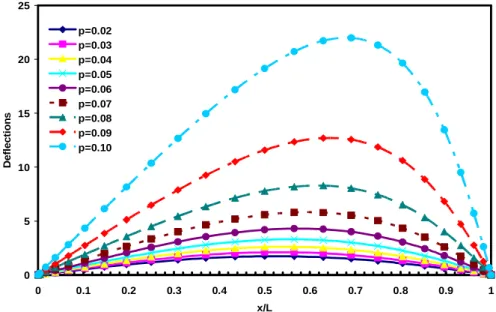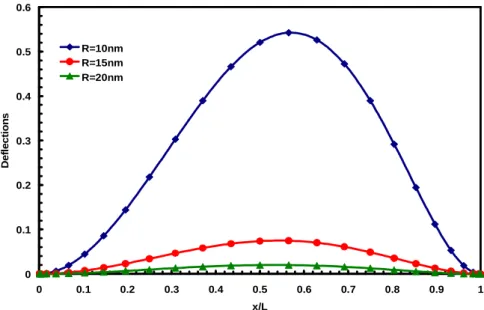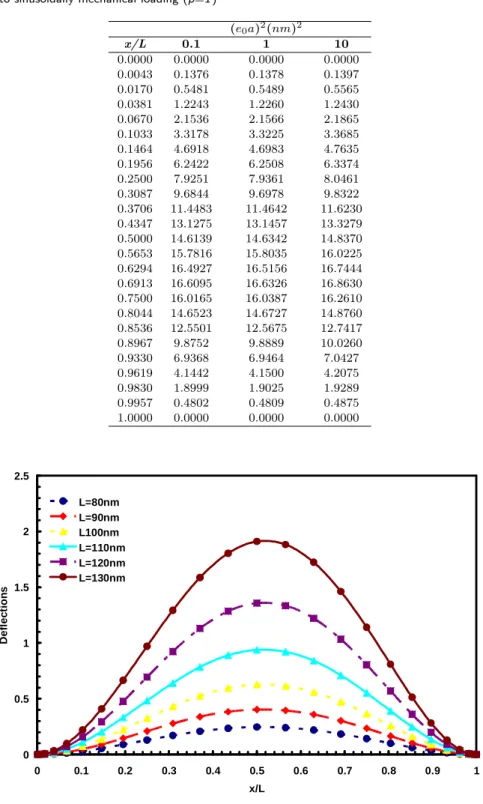Static analysis of tapered nanowires based on nonlocal
Euler-Bernoulli beam theory via differential quadrature method
Abstract
As a first endeavor, bending analysis of tapered nano wires with circular cross section is investigated. In this research, nonlocal elasticity theory based on Euler-Bernoulli beam theory is used to formulate the equations. Differential quadrature method (DQM) is employed to solve the gov-erning equations. Different parameters such as nonlocal pa-rameter, length and radius of tapered nano wires are also considered. The results of present work can be used as bench marks for future works.
Keywords
Tapered nanowires, Nonlocal Euler-Bernoulli beam theory, Differential quadrature method, Static analysis
Maziar Janghorbana
aDepartment of Mechanical Engineering,
Shi-raz Branch, Islamic Azad University, ShiShi-raz, Iran
Received 04 Apr 2012; In revised form 18 Apr 2012
∗Author email: maziar.janghorban@gmail.com
1
1 INTRODUCTION
2
Nonlocal theories were used for studying micro and nano structures for several times. Reddy
3
[18] reformulated various available beam theories, including the Euler–Bernoulli, Timoshenko,
4
Reddy, and Levinson beam theories, using the nonlocal differential constitutive relations of
5
Eringen. Zhang et al [25] studied the free transverse vibrations of double-walled carbon
nan-6
otubes using a theory of nonlocal elasticity. Wang et al [21] investigated the buckling analysis
7
of micro- and nano-rods/tubes based on nonlocal Timoshenko beam theory. The small scale
8
effect on the vibration analysis of orthotropic single layered graphene sheets was studied by
9
Pradhan and Kumar [16]. Elastic theory of the graphene sheets was reformulated using the
10
nonlocal differential constitutive relations of Eringen. Pradhan [15] presented the buckling of
11
single layer graphene sheet based on nonlocal elasticity and higher order shear deformation
12
theory. Jomehzadeh and Saidi [7] decoupled the nonlocal elasticity equations for three
dimen-13
sional vibration analysis of nano-plates. Malekzadeh et al [11] proposed the free vibration of
14
orthotropic arbitrary straight-sided quadrilateral nanoplates using the nonlocal elasticity
the-15
ory. The formulation was derived based on the first order shear deformation theory. Civalek
16
et al [14] investigated the free vibration and bending analyses of cantilever microtubules based
17
on nonlocal continuum model. Wang and Liew [23] studied the application of nonlocal
con-18
tinuum mechanics to static analysis of micro- and nano-structures. Aghababaei and Reddy [2]
19
presented the nonlocal third-order shear deformation plate theory with application to
bend-20
ing and vibration of plates. Analytical solutions of bending and free vibration of a simply
tions which were then solved by a direct iterative method to obtain the nonlinear vibration
33
frequencies of single-walled carbon nanotubes with different boundary conditions. Nonlinear
34
free vibration of embedded double-walled carbon nanotubes was studied based on Eringen’s
35
nonlocal elasticity theory and von Karman geometric nonlinearity by Ke et al [8]. Mustapha
36
and Zhong [13] studied the free transverse vibration of an axially loaded non-prismatic
single-37
walled carbon nanotube embedded in a two-parameter elastic medium using nonlocal Rayleigh
38
beam.
39
Nano wires have many interesting properties that are not seen in bulk or 3-D materials.
40
Many different types of nano wires exist, including metallic (e.g., Ni, Pt, Au), semiconducting
41
(e.g., InP, Si, GaN, etc.), and insulating (e.g., SiO2, T iO2. Surface effects on the elastic 42
behavior of static bending nano wires were studied by using a comprehensive Timoshenko
43
beam model by Jiang and Yan [6]. Fu and Zhang [4] established a continuum elastic model
44
for core–shell nano wires with weak interfacial bonding. Critical buckling loads and resonant
45
frequencies of simply supported nano wires were obtained by using the Ritz method. Song and
46
Huang [20] presented a model of surface stress effects on bending behavior of nano wires based
47
on the incremental deformation theory. The free longitudinal vibration of tapered nanowires
48
was investigated in the context of nonlocal continuum theory by Kiani [10]. The problem was
49
studied for the nanowires with linearly varied radii under fixed–fixed and fixed–free boundary
50
conditions. From the above works, it can be seen that tapered nano wires are rarely studied.
51
So, more discussions may be needed. From the knowledge of author, up to now, it is the
52
first time that static analysis of tapered nano wires is studied. The governing equations are
53
derived based on nonlocal elasticity theory using Euler-Bernoulli beam theory. In this study,
54
the differential quadrature method as an accurate numerical tool is adopted to discretize the
55
governing equations.
56
2 DIFFERENTIAL QUADRATURE METHOD
57
The basic idea of the differential quadrature method is that the derivative of a function, with
58
respect to a space variable at a given sampling point, is approximated as the linear weighted
59
sums of its values at all of the sampling points in the domain of that variable [3, 17, 19].
Figure 1 Nanowires [1]
Figure 2 Tapered nanowire model
In order to illustrate the DQ approximation, consider a function f(x,y) having its field on a
61
rectangular domain0 ≤ x ≤ a and0 ≤ y ≤ b.let, in the given domain, the function values be
62
known or desired on a grid of sampling points. According to DQ method, therthderivative of
63
a functionf(x, y) can be approximated as,
64
∂rf(x, y) ∂xr ∣
(x,y)=(xi,yj) =
N x
∑
m=1
Axim(r)f(xm, yj)= N x
∑
m=1
Axim(r)fmj (1)
where i=1,2,. . . ,Nx,j=1,2,. . . ,Nyand r=1,2,. . . ,Nx−1 65
From this equation one can deduce that the important components of DQ approximations
66
are weighting coefficients and the choice of sampling points. In order to determine the weighting
67
coefficients a set of test functions should be used in Eq. (1). For polynomial basis functions DQ,
68
a set of Lagrange polynomials are employed as the test functions. The weighting coefficients
69
for the first-order derivatives inξ-direction are thus determined as
coefficient of the third and fourth order derivatives (Cij, Dij) can be computed easily from 74
(Bij) by 75
Cij = N
∑
j=1
AijAijAij, Dij = N
∑
j=1
BijBij (4)
3 GOVERNING EQUATIONS
76
For an Euler-Bernoulli beam theory, the displacement field is assumed to be as follow,
77
u1=u(x, t)+z∂w/∂x, u2=0, u3=w(x, t) (5)
where are the axial and transverse displacements. The only nonzero strain of the Euler–
78
Bernoulli beam theory is [1],
79
εxx=∂u/∂x+z∂2w/∂x2 (6)
The equations for an Euler–Bernoulli beam theory are given by,
80
∂N/∂x+f =m0∂ 2
u/∂t2∂2M/∂x2+q(x)−∂(N ∂w¯ /∂x)/∂x=m0∂ 2
w/∂t2−m2∂ 4
w/∂x2∂t2 (7)
wheref(x) andq(x) are the axial and transverse distributed forces. According to the nonlocal
81
elasticity theory, the classic Hooke’s law for a uniaxial stress state is given by,
82
σ−(e0a) 2
∂2σ/∂x2=Eε (8)
whereσ(x) is the axial stress,e0 is a beam constant andαis an internal characteristic length. 83
The constitutive relation for a nonlocal Euler–Bernoulli beam theory is given by,
84
M−(e0a) 2
∂2M/∂x2=EI∂2w/∂x2 (9)
By performing the differentiation of this equation with respect to the variable x twice we
85
obtain
∂2M/∂x2−(e0a) 2
∂4M/∂x4=∂2(EI∂2w/∂x2)/∂x2 (10)
The equation of nonlocal Euler–Bernoulli beam theory now can be expressed in terms of
87
the displacements as,
88
∂2(−EI∂2w/∂x2)/∂x2+(e0a) 2
∂2[∂(N ∂w¯ /∂x) /∂x−q+m0∂ 2
w/∂t2
−m2∂ 4
w/∂x2∂t2]∂x2+q−∂(N ∂w¯ /∂x)/∂x=m0∂ 2
w/∂t2−m2∂ 4
w/∂x2∂t2 (11)
Using the DQ-rules for the spatial derivatives, the DQ-analogs of the governing Eqs. (11)
89
become
90
EI⎛
⎝
N ∑ j=1
Dijwi⎞
⎠+2(I∂E/∂x+E∂I/∂x)⎛⎝
N ∑ j=1
Cijwi⎞
⎠+q(xi).
(I∂2E/∂x2+2(∂E/∂x)(∂I/∂x)+E∂2I/∂x2)⎛ ⎝
N ∑ j=1
Bijwi⎞
⎠+(e0a) 2
[−∂2q(xi) /∂x 2
]=0.
(12)
It should be mentioned that for e0a=0, the above equation will reduce to the classical 91
Euler-Bernoulli beam theory. Two-types of boundary conditions are considered. These are,
92
Fully clamped, (at both ends)
93
W =0∂W/∂x=0 (13)
Simply supported, (at both ends)
94
W =0∂2W/∂x2=0 (14)
The discretized form of boundary condition can be obtained by,
95
Fully clamped, (at both ends)
96
Wi=0, N
∑
j=1
AijWj =0 (15)
Simply supported,(at both ends)
97
Wi=0, N
∑
j=1
where q0 is a constant parameter. In Table 1, the effects of nonlocal parameter on the deflec-106
tions of simply supported tapered nano wires subjected to sinusoidally mechanical loading are
107
shown. One can see that with the increase of nonlocal parameter, the deflections will increase.
108
The increase in the values of the deflections as the nonlocal parameter is varied is evident of
109
its importance contribution to the mathematical model. It is also shown that the maximum
110
deflection of tapered nano wire is not occurring at the middle of the wire, as it is expected.
111
In Fig. 3, the deflections of simply supported tapered nano wires subjected to sinusoidally
112
mechanical loading for different geometries are figured. The nonlocal parameter is assumed to
113
be 1nm. It can be seen that increasing the constant parameterp will increase the deflections of
114
nano wire. It is important to state that increase the constant parameterp is equal to decrease
115
the radius of nano wire.
0 5 10 15 20 25
0 0.1 0.2 0.3 0.4 0.5 0.6 0.7 0.8 0.9 1
x/L
D
e
fl
e
c
ti
o
n
s
p=0.02 p=0.03 p=0.04 p=0.05 p=0.06 p=0.07 p=0.08 p=0.09 p=0.10
Figure 3 The deflections of simply supported tapered nano wires subjected to sinusoidally mechanical loading for different geometries((e0a)
2 =1nm
2 )
116
In this figure, it is obviously shown that the maximum deflections shift to the right side
0 0.1 0.2 0.3 0.4 0.5 0.6
0 0.1 0.2 0.3 0.4 0.5 0.6 0.7 0.8 0.9 1
x/L
D
e
fl
e
c
ti
o
n
s
R=10nm R=15nm R=20nm
Figure 4 The effects of radius(R=r∣x=0)of fully clamped tapered nano wires on the deflections under
sinu-soidally mechanical loading((e0a)2=1nm2, p=0.05)
of nano wire as the constantp increase. The influences of radius(R=r∣x=0) of fully clamped 118
tapered nano wires on the deflections under sinusoidally mechanical loading are figured in Fig.
119
4. The figure indicates that increase of radius R, leads to the decrease of the deflections of
120
tapered nano wire. It is also shown that with less amount of parameter p and more amount
121
of radius R, the results for tapered nano wires are close to the results for nano wires with
122
constant cross section. In Fig. 5, the effects of length of fully clamped tapered nano wires are
123
investigated. As it is expected, in order to decrease the deflections of tapered nano wires, one
124
should decrease the length of them.
0.3706 11.4483 11.4642 11.6230 0.4347 13.1275 13.1457 13.3279 0.5000 14.6139 14.6342 14.8370 0.5653 15.7816 15.8035 16.0225 0.6294 16.4927 16.5156 16.7444 0.6913 16.6095 16.6326 16.8630 0.7500 16.0165 16.0387 16.2610 0.8044 14.6523 14.6727 14.8760 0.8536 12.5501 12.5675 12.7417 0.8967 9.8752 9.8889 10.0260 0.9330 6.9368 6.9464 7.0427 0.9619 4.1442 4.1500 4.2075 0.9830 1.8999 1.9025 1.9289 0.9957 0.4802 0.4809 0.4875 1.0000 0.0000 0.0000 0.0000
0 0.5 1 1.5 2 2.5
0 0.1 0.2 0.3 0.4 0.5 0.6 0.7 0.8 0.9 1
x/L
D
e
fl
e
c
ti
o
n
s
L=80nm L=90nm L100nm L=110nm L=120nm L=130nm
5 CONCLUSION
126
In this research, utilizing the nonlocal elasticity theory based on Euler-Bernoulli beam theory,
127
the deflections of tapered nano wires with circular cross section have been obtained. The
128
differential quadrature method was employed to convert the governing differential equations
129
into a linear system. It was shown that with the increase of nonlocal parameter and length
130
of tapered nano wires and with the decrease of radius of tapered nano wires, (R =r∣x=0) the 131
deflections will increase.
132
References
133
[1] http://www.amolf.nl/research/surface-photonics/highlights.
134
[2] R. Aghababaei and J.N. Reddy. Nonlocal third-order shear deformation plate theory with application to bending
135
and vibration of plates. Journal of Sound and Vibration, 326:277–289, 2009.
136
[3] R.E. Bellman and J. Casti. Differential quadrature and long term integration. J Math Anal Appl, 34:235–238, 1971.
137
[4] Y. Fu and P. Zhang. Buckling and vibration of coreshell nano wires with weak interfaces. Mech. Re. Commun,
138
37:622–626, 2010.
139
[5] Y.G. Hu, K.M. Liew, Q. Wang, X.Q. He, and B.I. Yakobson. Nonlocal shell model for elastic wave propagation in
140
single- and double-walled carbon nanotubes.J. Mech. Phys. Solids, 56:3475–3485, 2008.
141
[6] L.Y. Jiang and Z. Yan. Timoshenko beam model for static bending of nanowires with surface effects. Physica E:
142
Low-dimensional Systems and Nanostructures, 42:2274–2279, 2010.
143
[7] E. Jomehzadeh and A.R. Saidi. Decoupling the nonlocal elasticity equations for three dimensional vibration analysis
144
of nano-plates.Composite Structures, 93(2):1015–20, 2010.
145
[8] L.L. Ke, Y. Xiang, J. Yang, and S. Kitipornchai. Nonlinear free vibration of embedded double-walled carbon
146
nanotubes based on nonlocal timoshenko beam theory. Comput Mater Sci, 47:409–417, 2009.
147
[9] K. Kiani. Application of nonlocal beam models to double-walled carbon nanotubes under a moving nanoparticle.
148
part i: theoretical formulations.Acta Mech, 2010. DOI 10.1007/s00707-010-0362-1.
149
[10] K. Kiani. Free longitudinal vibration of tapered nanowires in the context of nonlocal continuum theory via a
150
perturbation technique. Physica E, 43:387–397, 2010.
151
[11] P. Malekzadeh, A.R. Setoodeh, and A. Alibeygi Beni. Small scale effect on the free vibration of orthotropic arbitrary
152
straight-sided quadrilateral nanoplates.Composite Structures, 2011. doi: 10.1016/j.compstruct.2011.01.008.
153
[12] T. Murmu and S. Adhikari. Nonlocal vibration of carbon nanotubes with attached buckyballs at tip. Mech. Re.
154
Commun, 2011. doi:10.1016/j.mechrescom.2010.11.004.
155
[13] K.B. Mustapha and Z.W. Zhong. Free transverse vibration of an axially loaded non-prismatic single-walled carbon
156
nanotube embedded in a two-parameter elastic medium. Comput Mater Sci, 50:742–751, 2010.
157
[14] ¨O.Civalek, C. Demir, and B. Akg¨o¨oz. Free vibration and bending analyses of cantilever microtubules based on
158
nonlocal continuum model. Math. Comput. Appl, 15:289–298, 2010.
159
[15] S.C. Pradhan. Buckling of single layer graphene sheet based on nonlocal elasticity and higher order shear deformation
160
theory. Physics Letters A, 373:4182–8, 2009.
161
[16] S.C. Pradhan and A. Kumar. Vibration analysis of orthotropic graphene sheets using nonlocal elasticity theory and
162
differential quadrature method. Composite Structures, 93:774–779, 2011.
163
[17] J.R. Quan and C.T. Chang. New insights in solving distributed system equations by the quadrature methodi:
164
Analysis. Comput. Chem. Eng, 13:779–788, 1989.
165
[18] J.N. Reddy. Nonlocal theories for bending, buckling and vibration of beams. International Journal of Engineering
166
Science, 45:288–307, 2007.
[25] Y.Q. Zhang, G.R. Liu, and X.Y. Xie. Free transverse vibrations of double-walled carbon nanotubes using a theory
180
of nonlocal elasticity.Nuclear engineering Design, 71:1–7, 2005. 195404.
![Figure 1 Nanowires [1]](https://thumb-eu.123doks.com/thumbv2/123dok_br/18884641.423531/3.892.294.546.126.370/figure-nanowires.webp)


